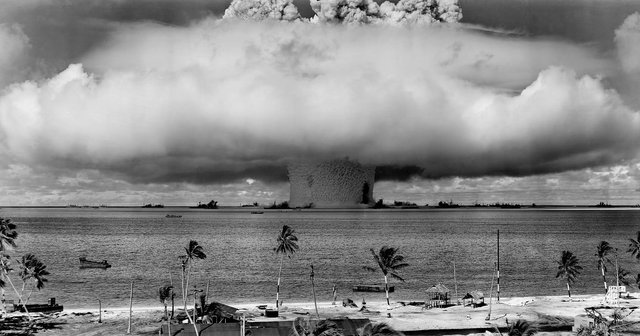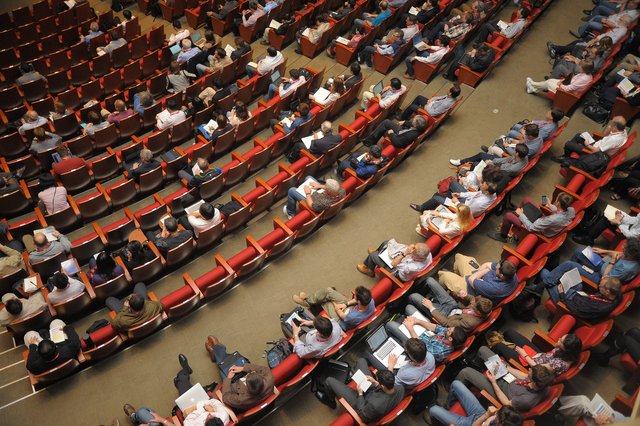(NF.1) Per aspera ad astra
This text is the first in my "Nuclear Fusion" (NF) series. Practically, it is an English translation of my already published article in Serbian and full version of "From Hardships to Star Bootle" article published by Fusion in Europe. I finally found proper way (read "SteemIT") to publish the full version!
ITER, the first fusion device that will give positive energy output, will be a tokamak. But why tokamak? A straightforward answer is: “because it is the best option we have!” In this story, we will briefly try to go through the hard time scientists had to pass starting from the WWII to the tokamak as the winning concepts.
Initial Secrecy
Experimental and theoretical discoveries during the first two decades of the 20th century lead to the fundamentals of atomic and nuclear physics. Just after in the 1920s, scientists realized that the nucleus keeps in itself an immense amount of energy. The first attempts to grasp nuclear energy was through “cold fusion”, which is complete nonsense by today's level of knowledge. Next in the queue was fission and finally thermonuclear fusion (or simply fusion). First experimental ideas about controlled fusion emerged in the USSR and the USA just before the WWII, but both projects were abandoned before becoming a reality. Immediately after the WWII, the UK approached the issue organized in few research centers. In March 1951, Argentinian dictator Peron called a press conference where he claimed that his laboratory had achieved controlled fusion and will be soon used for the power generation. Even though the claim was shown to be false very fast, the size of the news contributed to the larger interest and motivation of the USSR and the USA scientists. France, Sweden, and Japan also joined taming the fusion later in the 1950s.

Besides building the fusion devices, studying fusion plasma physics also intensified in the middle of the last century. Few examples will be given for an illustration: (i) in almost all the devices plasma showed to be very unstable, (ii) famous theoretician Bohm characterized the transport and particle losses of plasma by defining diffusion coefficient, and (iii) Lawson found a criteria that plasma has to fulfill to give positive net output power – the criteria that torment scientist's brains worldwide even today.
Even though fusion plasma physics advanced, some things were “discovered” more times, as the fusion research was classified at that moment – mostly due to the Cold War/Iron Certain and a potential military usage.
However, things were not so dark all the time – e.g. Kurchatov, the leader of the Soviet fusion program, officially visited Harwell, the main fusion research center in the UK, in 1956. That same year, Artsimovich (Kurchatov's successor) participated in the symposium in Stockholm. Western scientists were shocked by the level of openness and sincerity that Soviet visitors talked about fusion. As the response to Kurchatov, Harwell's team was first to declassify their documents already in January 1957. Afterward, Western countries talked more and more openly about fusion research, which mostly consisted of challenges and issues without solutions. The next big conference has been anticipated to show what the Soviets have to show.
Squeezing & Trapping in Geneva
All cards regarding the magnetic confined fusion were on the table at the famous Conference in Geneva 1958 (inertial confined fusion was only theoretical at that point). A vast amount of result was presented regarding two main principles at the time – a pinch and a magnetic mirror. Besides those two, results from USA stellarator were also shown.

Pinch uses an magnetic field to squeeze plasma. Pinches could be open with the cylindrical shape or closed having the ring-like shape, i.e. toroidal. Depending on the current direction through the plasma, pinch could be Z-pinch (current along cylinder or torus) and θ-pinch (poloidally, around the ring). Open Z-pinch was investigated in Moscow and Berkley, while other centers in the USA had open θ-pinches. The most prominent example of θ-pinches was Scylla located in Los Alamos, as it had the first thermonuclear neutrons. The UK was leading in the toroidal pinch systems having the massive ZETA device. Besides the UK, also the USSR, the USA, France, and Sweden presented results from their toroidal devices.
Magnetic mirror keeps plasma as a particle trap – stronger magnetic field at the edge repels the particles towards the center, where the magnetic field is weaker. Using low magnetic field mirrors, researchers tried to have continuous plasma in Moscow and few centers across the USA. A beam of energetic ions was often used to reach the thermonuclear conditions. However, it was rapidly realized that this is a dead end as the radial losses were calculated to be too large. Some the USA centers developed pulsed magnetic mirrors with the stronger magnetic field, which slowly evolved into the θ-pinch.
Stellarator is an attempt to produce plasma without current flowing through it, which provides full control over plasma by the magnetic coils. This is done either with bending of a torus and/or bending the coils. The idea originates from Princeton, by Spitzer 1951, although Moscow scientists had a similar idea which did not go further from the blueprint.
A wide gathered knowledge was presented at the Conference, which unfortunately mostly consisted of problem lists. Almost all the devices had reported the neutrons, which will be proven sooner or later to be of the non-thermonuclear origin, i.e. they are not due to fusion (except for Scylla). As the Conference summary, 'filling the gaps' in fusion plasma physics was emphasized and it was obvious that reaching the fusion power plant on Earth will be far more difficult than expected 10 years before the Conference.
Losing the Optimism
Soon after the Geneva Conference, fusion community is enlarged by West Germany, the Netherlands, and Switzerland, while the UK research centers are all moving to Culham – the place where the largest ever build tokamak – JET – will be built in 20 years.

Thanks to Scylla, the θ-pinch concept had a real boost after the Conference. Nevertheless, open systems were slowly abandoned as a potential fusion power plant, despite their tremendous contribution to the fusion physics and engineering. Among the many reasons, we can mention the edge losses and unpractical dimension of the power plant measured in hundreds of meters. Meanwhile, in Moscow, scientists worked on Field-Reversed Configuration (FRC) for better plasma stabilization. The idea is to get a self-organized opposite toroidal field of the external toroidal field in the device, like a ring in the cylinder. In two decades, this will lead to the concept of spheromak.
The British pinch ZETA withstand disappearance of toroidal pinches and found the spontaneous reversed toroidal field at the plasma edge. Later on, this discovery will lead to the Reversed-Field Pinch (RFP).
Dutch team designed a new concept, the toroidal system combining the Z- and θ-pinch, a so-called “screw-pinch”.
The losses in magnetic mirrors were reduced bending the coils in baseball and yin-yang shape. The improvements were unimportant for practical purpose and “cusp” (because plasma has such shape) mirrors were introduced for more stable plasma. The cusp mirrors lead to the toroidal devices with the conductor implemented inside the vacuum chamber. As the conductor would levitate during the discharge, the devices were named levitrons or multipoles if the number of conductors would be larger than one. This concept was never seen as a potential power plant, but it helped in understanding the studies of plasma stability and transport.
Stellarators were considered as the best candidate for fusion power plant in the 1960s. Mostly due to their intrinsic feature to have continuously closed system plasma. After Geneva 1958, Germans and Soviets were the first to build their own stellarator after the USA, while other countries join the stellarator community very fast. As there are numerous ways to make current-free plasma but calculation was cumbersome and complicated (there were no super-computers as today), the main design principle was “trial-and-error”.
International Atomic Energy Agency (IAEA) emerged as the result of the Geneva Conference. The IAEA started to organise Fusion Energy Conference, held in Salzburg 1961 and Culham 1965. There was no larger advance presented – either particle losses were too huge or efficient heating was lacking or the plasma would be unstable and too short.
The Siberian Sun
The 3rd Fusion Energy Conference was held in Novosibirsk 1968, and the future of the fusion as an energy source on the Earth was a bit discouraging. One could say that this was the best moment for tokamak to reveal itself in all the glory.
Practically, tokamak is a variant of the toroidal Z-pinch. What makes it different is very strong stabilizing magnetic field. From bare beginnings, the Soviet scientists made a difference between toroidal pinches with weak and strong magnetic field. Tokamak works like a transformer, where ring-shaped plasma is the secondary winding, while primary winding is the coil in the middle of the ring. The initial concept is made by Saharov and Tamm in 1950. During the Geneva Conference tokamak plasma was unstable and no result was presented.

Artsimovich showed achievements of the tokamak T-3 in Novosibirsk. T-3 had an electron temperature of 10 million Kelvins, ions had temperature half of that and energy confinement was 50 times larger than theory predicted. Of course, the USA and the UK scientists did not accept this results easily, especially after seeing the bad conditions in which Soviet research was conducted. Besides, the method used to estimate electron temperature was very indirect and this only enlarged the critics. To solve the controversy, UK sent to Moscow a team that will measure electron temperature more directly based on Thomson scattering, which will finally confirm Artsimovich's numbers.
The tokamak astonishing results made it superior in comparison to the all other fusion device concepts, which made all worldwide research centers to make their own tokamak. Australia was the only country besides the USSR to have a tokamak before the Novosibirsk Conference and around 15 tokamaks were built in total up to that time. During the 1970s the fusion research was conducted on almost 80 tokamaks and 3 largest tokamaks ever made (JET, TFTR, and JT-60) have been already being designed.
Actually, in Novosibirsk tokamak just confirmed already 10 times better results than stellarator reported in Culham 1965, but this was seen as Soviet propaganda. Anyway, stellarators continued to develop in much lower number than before due to their intrinsic continuous operation. The biggest surprise was the USA centers that abandoned stellarator concept completely for a few years, even though they were the main stellarator advocates. Further stellarator development will have to wait for the invention of a super-computer.
Beside tokamak and stellarator, aforementioned RFP system is the second alternative due to possible large magnetic pressure and achieving fusion without auxiliary heating next to the induction.
At the on of the 1960s, the fusion was still far from the power plant level, but the two-decade lasting path from simplest pinches and mirrors to the tokamak had improved plasma for many order of magnitude. Finally then, after choosing the best “star bottle”, one could think about “star-like” power plant here on the Earth.
If you reached the end, please feel free to ask anything in the comments. I will either try to answer you in the comment or even make the new post. If the topic shows popular I will delegate some power to you - I guess that would be fair ;)
Congratulations @wlakinsson! You have completed the following achievement on the Steem blockchain and have been rewarded with new badge(s) :
Click on the badge to view your Board of Honor.
If you no longer want to receive notifications, reply to this comment with the word
STOPDo not miss the last post from @steemitboard:
Congratulations @wlakinsson! You have completed the following achievement on the Steem blockchain and have been rewarded with new badge(s) :
Click here to view your Board of Honor
If you no longer want to receive notifications, reply to this comment with the word
STOPDo not miss the last post from @steemitboard: